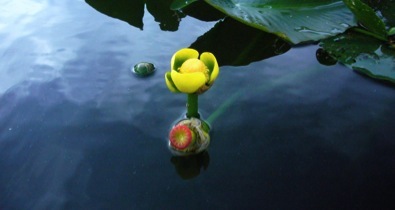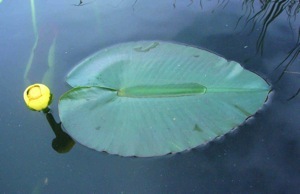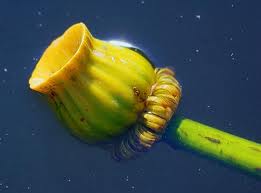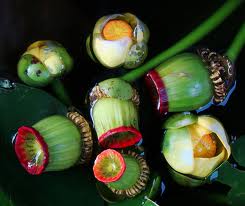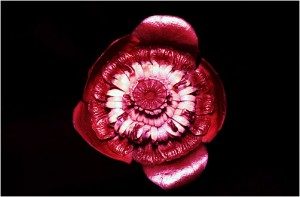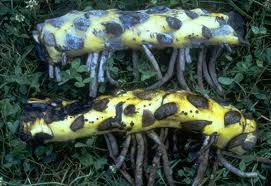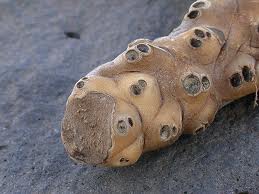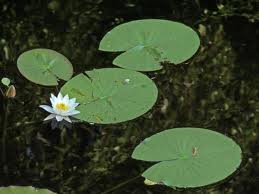Picking Pond Lilies: Nuphar Luteum subsp. advena
Once upon a time there was just one Nuphar luteum… and it was good.
The Yellow Pond Lily was native nearly everywhere: Europe, North America, South America, even parts of Asia such as Japan. And everywhere that people went, the Nuphar was sure to go…ah… be there.
But then scientists, those brilliant fellows that they are, finally noticed what everyone else had been noticing for centuries; that not all Nuphar looked alike. The Nuphar in Paris, France, is not the same Nuphar in Paris, Maine, or in Paris, Japan, if there is such a place. No problem, the science-types said, they’re just variations of the one Nuphar, subspecies as it were. But then the Imperial Empirical got better at analyzing plants on the molecular level and announced there are different species of Nuphar and different variations of the species.
Now the Nuphar has an identity crisis. Is it Nuphar Luteum subsp advena, or Nuphar advena? The important part is that we know it when we see it.
Botanists think there now may be some two dozen different kinds of Nuphar, maybe eight in the United States alone. The differences are often subtle, and not everyone agrees how many subspecies there are, or even how many Nuphar there are. But, most do agree the Yellow Pond Lily was a convenience store for the ingenious indigenous.
One tribe of eastern American Indians reportedly ate the spongy roots, cooking them in stews, a point I doubt seriously if it is the same Nuphar I have locally. They also supposedly dried them and ground them into flour for baking. I greatly doubt that as well. There is only one old report — one — of that being done and I think the writer got it wrong, or it involved different species with different characteristics. Nuphar roots are mentioned almost exclusively as a source of medicine not food. The seeds, however, were definitely esteemed and a major food source of western Indians, and they did not eat the roots.
Called “wokas” by the Klamath Indians, the seed pods were gathered and the seeds popped like miniature popcorn, or dried and stored, or ground into flour. They were also used to make gruel and thicken soup. Tens of thousands of acres of wokas were harvested by the Klamath, and presumably other tribes as well.
Young Nuphar leaves were added to soups and stews. Flowers were used to make tea. Older leaves and roots also contain tannin. The leaves were used to stop bleeding, as many astringents are. The roots were used in tanning and as an analgesic. They were also used as a staunching poultice for cuts, swelling, and other ailments. Dry root powder was used to stop bleeding, which is very believable considering how astringent they are.
My own experience with the Nuphar has not been as successful as the Indians, per se. I’ve collected many seed pods (see the red rimmed pod in the picture) and washed the slimy seeds for “popping.” They do “pop” when cooked like popcorn, and are quite tasty, but they barely pop. It is more accurate to say they crack open rather than puff up like popping corn does. The bitterness of the seeds vary. Some are mildly bitter, some are not. They are worth collecting, and can easily be done wading, or from a canoe, or the like. To process the seeds put the pods in water and let them rot for three weeks. Not two weeks. Three. The natural enzyme action removed the bitterness and related foul taste. Then removed the seeds and air dry. You now have a versatile staple. As for eating the roots….
I was canoeing on the lower Wekiva River in the mid 90’s when the water was low. I saw a Nuphar root for the taking. It was only about four feet long — they can grow four times that length. It was about four inches through, giving me plenty of root to experiment with. The main issue is tannin, the same problem one has with acorns. It has to be leached out. There may be other chemicals there as well.
So, I cut off about a foot of root, peeled it, cubed it. It has the texture of eggplant on steroids. I put it to simmer in a very large pot, pouring off the water nearly every hour or so when it turned coffee colored. After two days of nearly constant simmering I gave up. The root seemed to be an endless source of tannin, and it remained too bitter to eat. If one had a flowing source of fresh water, the tannins might leach out naturally over time — as one can do with bitter acorns — but simmering in changes of fresh water for two days did not do it.
Then I considered that, like acorns, putting Nuphar roots in cold water and raising the water to boiling might bind the tannin to the starch. That would mean Nuphars might have to be processed in continuous cold water or continuous boiling water to be made edible. Or it may be that only young, short nuphar roots are edible. It was an inquiry I put off for several years.
A few years later I bought a house and put in a small enclosed water pond. I raised some Nuphar in it. One spring I took out a piece of root, a foot long and three inches through, young by Nuphar standards. I peeled it. The flesh was a yellowy white and with dark mustard flecks. I sliced it 1/8-inch thin, and for a full week leached it 24 hours a day in warm water. At the end of the week the slices looked the color of liver and root did not seem bitter. But it was also totally tasteless. What very little I ate didn’t seem to bother me but I don’t think it had much nutrition after a week and was a lot of work if it had any calories. Then I dried the pieces in my solar oven. They shrank some 90% and became very bitter, concentrating as it were the offending property. Nuphar might be a famine food if you had plenty of time, water and fuel to keep the water warm. The floating slices would not leech in room-temperature water. In warm water they would sink and leach. All in all I’ve never made the root edible.
Among published professionals in the foraging community no one has found the Nuphar root worthy of being called an edible. Perhaps tellingly, the Nuphar is one extremely common plant that is not mentioned by the comprehensive professor, Dr. Julia Morton, in her regional book, “Wild Plants for Survival in South Florida.” And while it was known in Europe it was not eaten there.
The plant has many local names. Nuphar (NEW-far) means nymph and comes to us from Arabic through Greek. Luteum (LEW-tee-um) means yellow. Pond collards refers to the edible young leaves and Brandy Bottle is in reference to the new flower — as in the picture on top— which has the aroma of brandy. Advena (add-VEEN-ah, means newly arrived.) Spatterdock is to the point; Dock is a word for a coarse weed and spatter is strewn about. It does look like it is spattered across a pond. Of course, Yellow Pond Lily says it all.
Environmentally, the Nuphar is important. It was green long before being green was keen. Its large leaves provide shade for fish and cover from predators. They are a home for all kinds of aquatic invertebrates which in turn are then eaten by fish. Here in Florida the Nuphar stem is a common place to find apple snail eggs, just above the water line, pink eggs exotic, white eggs natives. Beavers, muskrats, nutria and deer eat the leaves. The Indians used to capture deer when they were feeding on the leaves with their heads underwater. The roots, however, are supposedly toxic to cattle, no surprise there. Women reportedly did most of the gathering of the roots, particularly the eastern tribes. While they did wade or dive for them, they also took some from muskrat mounds, where they were stored. The western tribes focused more on the seeds. (And as an aside, the leaves can be pulped to make paper.)
In folklore, the Menominee Indians, who have been around the area of Wisconsin for some 5,000 years, said the Nuphar belonged to the “Underneath Spirits.” They thought is was the source of fog on lakes and that the plant represented “great medicine.” Perhaps they were right: From a medical point of view, the Nuphar had many uses. The Peterson’s guide of medicinal plants says the roots were used for cuts, inflammation, blood pressure problems and “sexual irritability.” (One doesn’t think of Indians having sexual irritability, what ever that means.) Modern research shows the roots contain “nupharine” which was explored as an opium substitute.
In 1910 the research team of A. Goris and L. Crete reported they had isolated a potential compound in the Nuphar, an amorphous, bitter alkaloid, C18H24O2N2, which they called nupharine. That report is: Sur La Nupharine, Bull. Sci., Pharmacol 17: 13-15. Their report was of little consequence until WWII when war threatened to interrupt the medical derivatives of opium, such as morphine. That, and reports from early Africa explorers, suggested the water lily (Nymphaea) might be a source of something similar to opium — note, not the Nuphar, though similar. J. Delphaut and J. Balansard began to experiments on the water lily, Nymphaea albas. Their 1941 report is: Sur les properetes du Nenuphar (Nymphaea alba). Compt Rend. Hebd. Seances. Mem. Soc. Biol. 135: 1665-1670. Delphaut and Balansard found narcotic-like properties to the root of the Nymphaea alba, left. They were the ones who found the powdered roots would induce a deep sleep in mice, dogs and eels. This happened at the beginning of WWII, but there is no reference to the root being used during the war (see my Cat O’Nine Tail blog about another WWII plant experiment.)
All of that might have been almost interesting and dusted away in old journals if it were not for an article written by Prof. William A. Emboden, of California State University, in 1977, and printed 10 Nov. 1977 in Economic Botany, Volume 32, Number 14. Emboden had an interest in the narcotic properties of plants. His article was an attempt to identify which narcotic-like water lily was used in ancient Egyptian society by studying hieroglyphics and other references. In review of the literature, he mentioned the above research. In some lilies the relevant narcotic-like part appears to be the root, in others the stalk, and in others the flower itself. Clearly the Indians, even with the Nuphar, were on to something, in some manner of medicinal preparation.
What this all suggests for foraging purposes is that the seeds of the Nuphar are the part of the plant to forage. They’re fairly easy to identify and collect. Try the leaves if you are desperate and like bitter. The root might have some medical properties but it is not food as I understand the word.
Green Deane’s “Itemized” Plant Profile
ITEMIZED: Mostly submerged, leaves alternate, up to 16 inches long with wavy edges, elliptical to heart shaped. Submerged leaves are very thin and grow directly from rooted rhizome. Floating and erect leaves are attached to the stem. Yellow flowers, thick heavy roundish petals, blooms first appear in late spring and continue into early fall. Showy. Seed capsule ringed with red.
TIME OF YEAR: Leaves year round, flowers in spring. Seeds most of the year in Florida.
ENVIRONMENT: Ponds and still water area in slow streams.
METHOD OF PREPARATION: Young shoots and leaves cooked but might be too bitter to eat, seeds “popped” or otherwise cooked, tasty but labor intensive to clean from capsule. Instead of removing the seeds the capsules can be put in a bucket of water and the seeds allowed to rot out over three three weeks but the smell is formidable. The roots in my opinion are not edible. Tea from the flower petals.
Lastly, the large leaves can be used to wrap other food for cooking or transportation.

